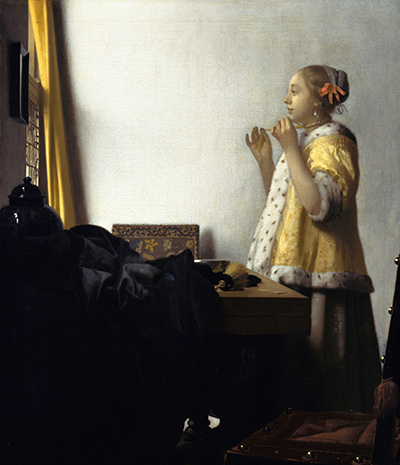Johannes Vermeer, a popular Dutch painter from the 17th century, painted the spectacularly moving Woman with a Pearl Necklace in 1664.
The Northern European painting portrays a young Dutch woman dressing herself up with a pearl necklace of course, apart from other things on her vanity table.
The young woman seems to be of the upper-class category in the social hierarchy and is seen in a yellow fur-trimmed coat and her hair is done up with matching yellow ribbons.
She is also wearing pearl earrings to match her necklace The depiction of a woman beautifying herself within an interior, domestic scene is what makes this painting stand out; after all the idea is pretty novel and the expressive profile of the lady makes it all the more appealing.
The young woman seems to be looking towards a light source (probably a window) towards the far left of the frame. On taking a first glance at the painting one would notice that the color yellow dominates it, from the yellow curtains to the rich lemon yellow tone of the fur jacket.
However, the drawn-back curtains in the painting tones down the light source, thus adding an element of darkness in the painting, which creates a perfect balance.
Moreover, a major portion of the painting is taken up by the white wall in the background, which sets a stage for the primary subject of the painting, the young woman. Since the wall is blank, one can concentrate on the woman’s action/expressions without any distraction. After all, the painting is titled ‘Woman with a Pearl Necklace’, therefore it is only right that viewers should focus on the woman in question!
The framed mirror in the painting seems to be made out of ebony, which indicates the kind of wealth the lady’s family has and her status too. Also, Vermeer attempted to create realism with the painting; if one were to take a closer look, one would be able to spot the microscopic brush strokes and the thin layers of different colors used in the painting, such as gray and white.
According to critics, the painting seems to suggest the lack of occupation and the triviality of the activities carried out by young women from the upper class category. The wash basin, powder brush and comb in front of the young woman in the painting only suggests her ample time for unimportant activities or vanity. Also, the woman is seen finishing up her beauty routine but the expression on her face is blank.
While her profile is definitely nice and appealing, the blank look on her eyes whilst clasping her pearl necklace seems to suggest that she is just looking vainly at probably the mirror. During the 17th century, the act of decorating or adorning the body with the help of objects or cosmetics is considered to be a vice, or ‘vanitas’ to be precise.
Vermeer was an expert at what he does and his talents as a painter were immense and unique. Even though there were plenty of Dutch Baroque painting depicting women at ‘toilet’, i.e. it was a common theme at that time, Vermeer’s works stand out from the crowd. With the help of a cadre of unique features, Vermeer made his works eye-catching, despite of them revolving around domestic themes. For instance, in this painting, the use of yellow and blue pigments and the depiction of domestic tools, expressive face of the women, curtains and ornate furniture makes the painting all the more exclusive!
What’s most unfortunate about Vermeer is that he only managed to achieve moderate success during his lifetime despite of being known for his mastery over the treatment of light (in paintings) and his creativity. Today, his works sell for tens of millions of dollars but he died in poverty.
The stillness and introspection of the painting is what gives it a unique touch, thereby making it a fine art painting. Moreover, Vermeer has a unique skill of creating a sense of intimacy or voyeurism in his paintings; this one in particular is a perfect example! The subject or the young woman is staring into the distance while dolling herself up, the look in her eyes shows that she is completely unaware of her surroundings. This is exactly what gives the viewer a feeling of voyeurism, as though he is peering into a female’s chamber.




